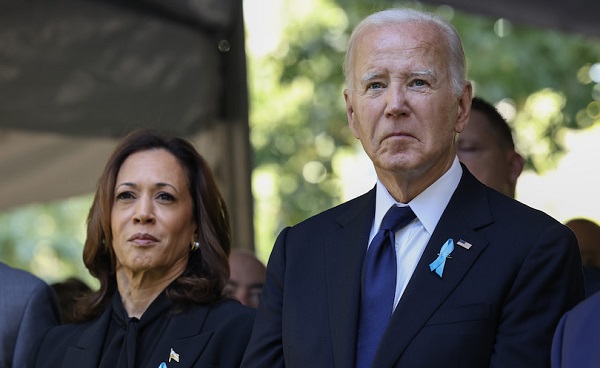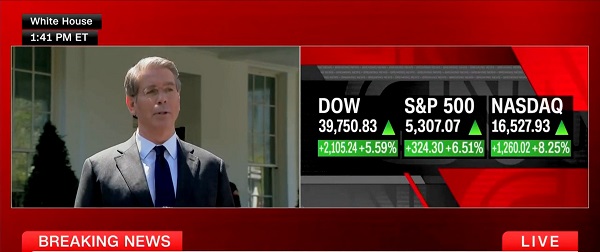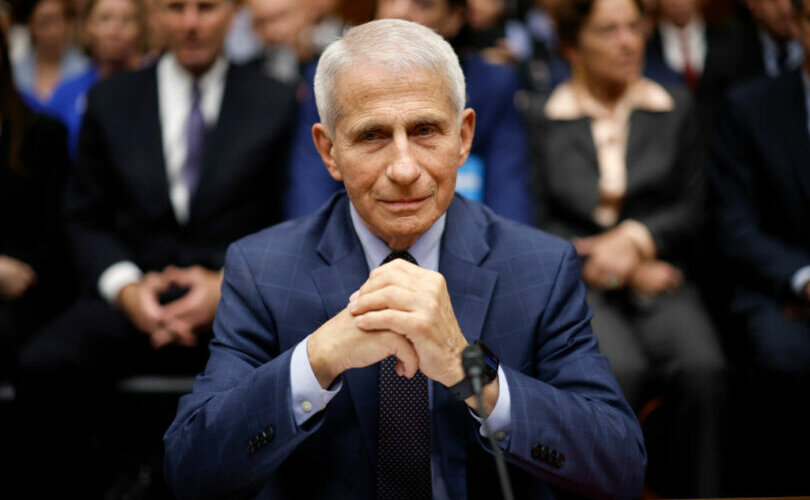Daily Caller
Biden Admin ‘Intentionally Buried’ Inconvenient Study To Justify Major Energy Crackdown, Sources Say


From the Daily Caller News Foundation
By Nick Pope
The Biden administration deliberately buried a final draft version of a study that would have undermined its January 2024 decision to pause approvals for liquefied natural gas (LNG) export projects, according to four Department of Energy (DOE) sources.
Former Energy Secretary Jennifer Granholm and former President Joe Biden announced the LNG freeze in January 2024, stating that it would remain in place until the DOE could conduct a fresh study of the climate and economic impacts of LNG export growth. The Biden DOE finalized a draft of the study in 2023 and subsequently buried it because the initial version’s findings would have contradicted the administration’s rationale for the LNG freeze, according to four sources inside the Trump DOE granted anonymity by the Daily Caller News Foundation to freely discuss a sensitive matter.
“The Energy Department has learned that former Secretary Granholm and the Biden White House intentionally buried a lot of data and released a skewed study to discredit the benefits of American LNG,” one DOE source told the DCNF. “They were prioritizing their own political ambitions over the interests of the American people, and the administration intentionally deceived the American public to advance an agenda that harmed American energy security, the environment and American lives.”
The Biden DOE had essentially completed the final draft version of the LNG impacts study by the end of September 2023, and that version was ready to be presented to top Biden officials shortly thereafter, Trump DOE sources told the DCNF. That particular iteration of the study, DOE sources told the DCNF, found that increasing U.S. LNG exports would actually bring about a reduction in global emissions relative to other scenarios.
That particular finding is at odds with Granholm’s analysis of the final version of the study released to the public in December 2024, in which she argued that any increase in LNG exports will result in higher global greenhouse gas emissions.
At the end of September 2023, a Biden administration official left a comment on the final draft version that instructed others to halt work on it until further notice, despite other language in the document stating that the final version was to be published sometime around the end of September 2023, Trump DOE sources told the DCNF. That version of the study was never released publicly, and the Biden DOE considered it to be a “working document” given that the agency subsequently categorized it as part of an internal deliberative process, according to DOE sources.
Additionally, the Biden DOE appears to have deleted numerous pages that appeared in the September 2023 draft version from what became the final version of the report released to the public at the end of 2024, the Trump DOE sources told the DCNF.
While the September 2023 and December 2024 versions of the paper bear the same name, the final version released to the public did not include a specific type of analysis of LNG exports known as the consideration of market effects, Trump DOE sources told the DCNF. That particular analysis — included in the buried September 2023 version of the study, but not the final product — found that U.S. LNG exports would bring down global emissions by displacing more polluting sources of energy abroad, and its absence from the December 2024 version allowed the Biden DOE to skew the final report’s findings against increasing LNG exports.
The evidence showing that the Biden administration buried the initial, politically inconvenient version of the study and misled the American public in the process will soon be transmitted to Congress and to the public, DOE sources told the DCNF.
Granholm and Biden each made statements after the pause was announced implying that the administration was freezing LNG export approvals to pursue answers that Trump DOE sources say had already been found, and that Biden officials chose to ignore. Specifically, both Biden and Granholm suggested that increased LNG exports would be a net negative for the global climate, with Granholm definitively saying as much after the final study was released to the public in December 2024.
“During this period, we will take a hard look at the impacts of LNG exports on energy costs, America’s energy security, and our environment. This pause on new LNG approvals sees the climate crisis for what it is: the existential threat of our time,” Biden said in a statement the day the pause was announced. “While MAGA Republicans willfully deny the urgency of the climate crisis, condemning the American people to a dangerous future, my Administration will not be complacent. We will not cede to special interests.”
Notably, House Speaker Mike Johnson recalled to The Free Press in January 2025 that Biden “genuinely didn’t know what he had signed” when he asked the president about the decision to freeze LNG approvals in January 2024, with the Republican adding that he left that meeting with the impression that Biden was not actually running the country in practice.
The DOE stated that it would “initiate” a review to determine whether increasing LNG exports is in the public interest in its statement on Jan. 26, 2024, the day the pause was announced.
Granholm claimed that the final version of the study released to the public in December 2024 demonstrates that “in every scenario, increases in LNG exports would lead to increases in global net emissions,” and that “a business-as-usual approach is neither sustainable nor advisable.” When the pause was first announced in January 2024, Granholm said in a statement that the review “will ensure that DOE remains a responsible actor using the most up-to-date economic and environmental analyses.”
Daily Caller
AI Needs Natural Gas To Survive


From the Daily Caller News Foundation
By David Blackmon
As recent studies project a big rise in power generation demand from the big datacenters that are proliferating around the United States, the big question continues to focus in on what forms of generation will rise to meet the new demand. Most datacenters have plans to initially interconnect into local power grids, but the sheer magnitude of their energy needs threatens to outstrip the ability of grid managers to expand supply fast enough.
This hunger for more affordable, 24/7 baseload capacity is leading to a variety of proposed solutions, including President Donald Trump’s new executive orders focused on reviving the nation’s coal industry, scheduled to be signed Tuesday afternoon. But efforts to restart the permitting of new coal-fired power plants in the US will require additional policy changes, efforts which will take time and could ultimately fail. In the meantime, datacenter developers find themselves having to delay construction and completion dates until firm power supply can be secured.
Datacenters specific to AI technology require ever-increasing power loads. For instance, a single AI query can consume nearly ten times the power of a traditional internet search, and projections suggest that U.S. data center electricity consumption could double or even triple by 2030, rising from about 4-5% of total U.S. electricity today to as much as 9-12%. Globally, data centers could see usage climb from around 536 terawatt-hours (TWh) in 2025 to over 1,000 TWh by 2030. In January, a report from the American Security Project estimated that datacenters could consume about 12% of all U.S. power supply.
Obviously, the situation calls for innovative solutions. A pair of big players in the natural gas industry, Liberty Energy and Range Resources, announced on April 8 plans to diversify into the power generation business with the development of a major new natural gas power plant to be located in the Pittsburgh area. Partnering with Imperial Land Corporation (ILC), Liberty and Range will locate the major power generation plant in the Fort Cherry Development District, a Class A industrial park being developed by ILC.
“The strategic collaboration between Liberty, ILC, and Range will focus on a dedicated power generation facility tailored to meet the energy demands of data centers, industrial facilities, and other high-energy-use businesses in Pennsylvania,” the companies said in a joint release.
Plans for this new natural gas power project follows closely on the heels of the March 22 announcement for plans to transform the largest coal-fired power plant in Pennsylvania, the Homer City generating station, into a new gas-fired facility. The planned revitalized plant would house 7 natural gas turbines with a combined capacity of 4.5 GW, enough power 3 million homes.
Both the Homer City station and the Fort Cherry plant will use gas produced out of the Appalachia region’s massive Marcellus Shale formation, the most prolific gas basin in North America. But plans like these by gas companies to invest in their own products for power needs aren’t isolated to Pennsylvania.
In late January, big Permian Basin oil and gas producer Diamondback Energy told investors that it is seeking equity partners to develop a major gas-fired plan on its own acreage in the region. The facility would primarily supply electricity to data centers, which are expected to proliferate in Texas due to the AI boom, while also providing power for Diamondback’s own field operations. This dual-purpose approach could lower the company’s power costs and create a new revenue stream by selling excess electricity.
Prospects for expansion of gas generation in the U.S. received a big boost in January when GE Vernova announced plans for a $600 million expansion of its manufacturing capacity for gas turbines and other products in the U.S. GE Vernova is the main supplier of turbines for U.S. power generation needs. The company plans to build 37 gas power turbines in 2025, with a potential increase to over 70 by 2027, to meet rising energy demands.
The bottom line on these and other recent events is this: Natural gas is quickly becoming the power generation fuel of choice to feed the needs of the expanding datacenter industry through 2035, and potentially beyond. Given that reality, the smart thing to do for these and other companies in the natural gas business is to put down big bets on themselves.
David Blackmon is an energy writer and consultant based in Texas. He spent 40 years in the oil and gas business, where he specialized in public policy and communications.
Business
Scott Bessent Says Trump’s Goal Was Always To Get Trading Partners To Table After Major Pause Announcement


From the Daily Caller News Foundation
By
Secretary of the Treasury Scott Bessent told reporters Wednesday that President Donald Trump’s goal was to have major trading partners agree to negotiate after Trump announced a 90-day pause on reciprocal tariffs for many countries after dozens reached out to the administration.
Trump announced the pause via a Wednesday post on Truth Social that also announced substantial increases in tariffs on Chinese exports to the United States, saying 75 countries had asked to talk. Bessent said during a press event held alongside White House press secretary Karoline Leavitt that Trump had obtained “maximum leverage” to get trading partners to negotiate with the April 2 announcement of reciprocal tariffs.
“This was his strategy all along,” Bessent told reporters during an impromptu press conference at the White House. “And that, you know, you might even say that he goaded China into a bad position. They, they responded. They have shown themselves to the world to be the bad actors. And, and we are willing to cooperate with our allies and with our trading partners who did not retaliate. It wasn’t a hard message: Don’t retaliate, things will turn out well.”
Dear Readers:
As a nonprofit, we are dependent on the generosity of our readers.
Please consider making a small donation of any amount here.
Thank you!
WATCH:
China imposed retaliatory tariffs on American exports to the communist country Wednesday, imposing an 84% tariff on U.S. goods after Trump responded to a 34% tariff by taking American tariffs to 104%.
“Based on the lack of respect that China has shown to the World’s Markets, I am hereby raising the Tariff charged to China by the United States of America to 125%, effective immediately,” Trump said. “At some point, hopefully in the near future, China will realize that the days of ripping off the U.S.A., and other Countries, is no longer sustainable or acceptable.”
“They kept escalating and escalating, and now they have 125% tariffs that will be effective immediately,” Bessent said during the press conference.
Bessent said that China’s actions would not harm the United States as much as it would their own economy.
“We will see what China does,” Bessent said. “But what I am certain of, what I’m certain of, is that what China is doing will affect their economy much more than it will ours, because they have an export-driven, flood the world with cheap export model, and the rest of the world now understands.”
The Dow Jones Industrial average closed up 2,962.86 points Wednesday, with the NASDAQ climbing by 1,755.84 points and the S&P 500 rising 446.05 points, according to FoxBusiness.
-

 2025 Federal Election2 days ago
2025 Federal Election2 days agoNo Matter The Winner – My Canada Is Gone
-

 2025 Federal Election2 days ago
2025 Federal Election2 days agoASK YOURSELF! – Can Canada Endure, or Afford the Economic Stagnation of Carney’s Costly Climate Vision?
-

 2025 Federal Election2 days ago
2025 Federal Election2 days agoCSIS Warned Beijing Would Brand Conservatives as Trumpian. Now Carney’s Campaign Is Doing It.
-

 2025 Federal Election1 day ago
2025 Federal Election1 day agoInside Buttongate: How the Liberal Swamp Tried to Smear the Conservative Movement — and Got Exposed
-

 Alberta2 days ago
Alberta2 days agoProvince to expand services provided by Alberta Sheriffs: New policing option for municipalities
-

 Alberta2 days ago
Alberta2 days agoMade in Alberta! Province makes it easier to support local products with Buy Local program
-

 International2 days ago
International2 days agoTulsi Gabbard tells Trump she has ‘evidence’ voting machines are ‘vulnerable to hackers’
-

 COVID-191 day ago
COVID-191 day agoCOVID virus, vaccines are driving explosion in cancer, billionaire scientist tells Tucker Carlson








